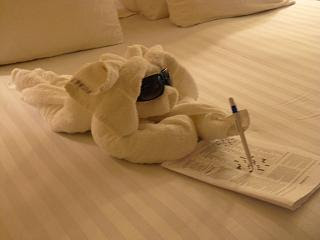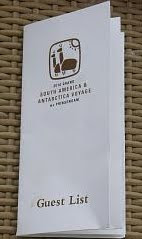 just 12 miles from the Peruvian border and is located on the coast of the driest desert, not only in South America, but in the world.
just 12 miles from the Peruvian border and is located on the coast of the driest desert, not only in South America, but in the world. Stretching 600 miles from Peru's southern border into northern Chile, the Atacama Desert rises from a thin coastal shelf to the pampas and their virtually lifeless plains that dip down to river gorges layered with mineral sediments from the Andes. The pampas bevel up to the foothills of the Andes, where alluvial salt pans give way to lofty white-capped volcanoes reaching 20,000 feet.
At its centre, a place climatologists call absolute desert, the Atacama is known as the driest place on Earth. There are sterile, intimidating stretches where rain has never been recorded, at least as long as humans have measured it.
Neither a blade of grass nor cactus stump can be seen any where. Many People who live here cannot even remember ever seeing it rain, as it rains only 2 to 3 times in every 100 years.
 The region has a mild climate. Water, a rarity in the Atacama Desert, comes from Río Lluta that originates in the Andes and flows through Northern Chile to Bolivia and supports lush vegetation.
The region has a mild climate. Water, a rarity in the Atacama Desert, comes from Río Lluta that originates in the Andes and flows through Northern Chile to Bolivia and supports lush vegetation.
There are often conflicts between the two countries over the syphoning-off of water from the river.
The area has been inhabited by native tribes from at least 6000 BC where corn, squash and cotton were cultivated and where pottery was made.
These people were later part of the Tihuanaco culture of Bolivia and the Inca Empire which extended as far north as Quito, Ecuador.
Once part of Bolivia, and Bolivia's access to the sea to export silver from the mines in Potosí, Arica became Chilean territory in the War of the Pacific.
Arica still functions as Bolivia's access to the sea, connected to Bolivia by train.
Chile has a Pacific Ocean coast line stretching nearly 3000 miles  and has an average depth of just over 100 miles inland. The population is currently about 17 million people.
and has an average depth of just over 100 miles inland. The population is currently about 17 million people.
It is one of just two countries (the other being Ecuador) in South America that does not share a border with Brazil.
This is the first of many stops we will be making in Chile over the next two weeks as we head towards the Antarctic on our Grand Voyage.
Today, on our first day in Chile, we have booked a tour through Cristan Ossandon of Sertours in Arica. The booking was conducted through the Internet and all finalised in October.
We meet up at the gates of the port and walk to the Cathedral where we pick-up the van for the 5 hour tour of the City and the Archaeological Museum where we will see the world's oldest mummies dating back to 10,000 BC (see photo).
the van for the 5 hour tour of the City and the Archaeological Museum where we will see the world's oldest mummies dating back to 10,000 BC (see photo).
We will then visit the Azapa Valley to observe the incredible Tropilla Geoglyphs followed by a further visit to see the Cerro Sagrado Geoglyphs.
Later in the morning we will enjoy an Aymara (local India tribe) picnic.
Our party today consists of 13 persons all of who I had introduced to the tour via Cruise Critic. The group from our ship was made up of: Lin, Gerry and Gary, Robin and Jennifer, Rosalyn and George, Lee and Lorraine, Dot and George plus of course us two.

At 9.00 sharp we started off on foot exploring the small centre of the town including the Cathedral and the Governors Residence.

Before visiting the incredible Geoglyphs stretching 50 foot in length on the hills surrounding Arica we visited the railway station, the former Customs House and a huge fruit and vegetable market called Terminal Agropecuario.

Some produce was quite expensive by our standards but others quite cheap. For example one of the huge water melons, shown in the picture with Maria, were UK30 pence or US50 cents.

Essentially these huge displays of llamas and humans built of rocks on the sandy side of the hills are thought to be a directional signage system that was introduced about 550 years ago to guide the local tribal people towards the Pacific Ocean. The llamas always point toward the ocean.
While taking photos of these amazing 'drawings' we can across an enterprising Pisco and wine salesman with a good supply of samples of the various Pisco Sours he sold.
I had heard that the Mango Pisco Sour was a very acceptable cocktail so ventured to have my first sample of this delicious drink. It was a good job our son-in-law Paul wasn't with us as he a bit of a thing for Margaritas and I could see him getting very quickly hooked on this new discovery. The sample was so good I decided to buy a bottle as well as the more traditional Lemon Pisco Sour.
These will make rather nice pre-dinner drinks to pour ourselves but of course have increased our already large alcohol mountain!.


Our last stop was about 10 miles outside the town at the Archaeological Museum of San Miguel Azpapa.
The well presented displays here begin 10,000 years ago and progress until the present time. Chinchorro mummies from the Andes and Atacama Desert are reputed to be the worlds oldest remains. They were a fascinating sight and displayed as part of the history of the region.
Unfortunately we were unable to visit the nearby Lluta Geogglyphs as these hillside drawings, again representing llamas and humans, are designed to be viewed from the sky, and they didn't have aeroplanes in those days did they?

Today is the birthday of Queen Beatrix of the Netherlands so it's formal night again on the Prinsendam with a very Dutch menu. However, as I'm still not 100% and off my food I think we will just go up to the less formal Lido restaurant and have a bite there without all the fuss of a 5 course dinner.








.JPG)
.JPG)
.JPG)
.JPG)
.JPG)
.JPG)
































